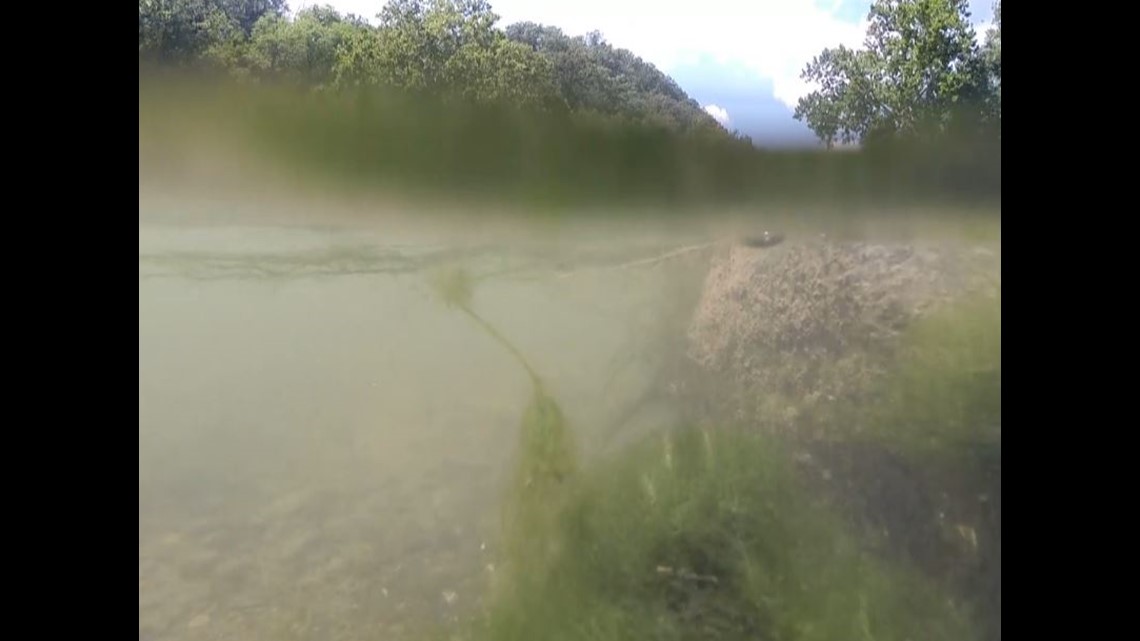WASHINGTON — The same type of blue-green algae that is connected to the death of four dogs -- three in North Carolina and one in Georgia -- has been found this summer in Maryland.
A couple in Georgia shared the heartbreaking story of their dog Arya’s death over the weekend, a lazy Saturday at the lake turned tragic within a matter of hours. Meanwhile, on Friday three dogs all belonging to the same owner died in North Carolina after swimming in a pond.
The link between the two appears to be a blue-green algae that’s highly toxic to dogs -- it can kill a pup as fast as 15 minutes after getting into their systems.
RELATED: Georgia couple shares warning on toxic algae after dog dies less than an hour after swimming in lake
"We took our sweet Arya to the lake and had the best day playing ball and swimming around! About 30 minutes later on the drive home, we noticed her making weird noises ..." Morgan Fleming wrote on Facebook.
The border collie died shortly after she began vomiting in the car.
What is blue-green algae?
Here are some important things to know about blue-green algae:
- It’s actually a bacteria: The bacteria is called cyanobacteria and when it spreads in a body of water it can produce a blue-green color in the water or the kind of thick, green layer that has the appearance of “pea soup.”
- It’s most common in non-flowing freshwater: Think ponds and lakes, rather than rivers and creeks. But remember, rivers and creeks can also often sit still and give rise to the algae.
- It’s also common down South: According to VCA Hospitals, blue-green algae flourishes most where the climate is hot and humid and water is warm. That describes basically every corner of the Southeast in the summer.
- It’s difficult to tell it's there: Dr. Mark Aubel of Greenwater Laboratories, said "your typical layperson will not be able to tell one algae from another, or a good from a bad," and that if you see any algae, it's best to play it safe with your pup.
- There are, however, warning signs: The "blooms" tend to clump together near the surface water and could be anywhere from bright green to brownish. In general, if parts of the water appear to be thick and mucky, there's a chance it’s because of blue-green algae.
- It’s highly toxic to dogs and other animals: The more obvious symptoms include sudden vomiting, diarrhea and seizures. Dogs who’ve ingested the algae will also likely appear weak and disoriented, and probably will have difficulty breathing.
- It eventually causes liver poisoning: Blue-green algae attacks a dog’s liver and causes it to shut down, which is usually the ultimate cause of death in these cases. The Marietta couple did not have an autopsy performed, but that their dog’s symptoms and how rapidly they progressed were consistent with algae poisoning. In North Carolina, the three dogs died of liver failure, according to their vet.
- It’s very difficult to treat: There’s no known antidote to the toxins, so typically the only chance you have is to get to a vet who can flush the toxins quickly, usually by induced vomiting. But chances with that are still slim. "Regardless of species, the toxins enter the system so quickly that the animal is usually sick before reaching medical care," VCA Hospitals said. "It is often too late to remove the toxin."
- The only sure thing is to avoid algae entirely: All the experts agree -- if there’s algae present, or it even seems like algae might be present, don’t take the risk.


Maryland
In Maryland, Anne Arundel County officials on July 3 warned of a harmful blue-green algae bloom in Lake Waterford in Pasadena. At the time, the county’s health department urged residents to avoid direct water contact and keep pets away from the affected body of water, Baltimore's CBS station reported.
Two weeks later, the state Department of Natural Resources found potentially harmful algae during a sample in the North East River near Charlestown in Cecil County, Baltimore's CBS station reported.
Who do I contact to report a harmful algal bloom?
Officials said to report harmful algal blooms call the Department of Natural Resources, Tidewater Ecosystem Assessment Division at 410-260-8630 during normal business hours. If there are fish kills, fish health, or human health concerns associated with the observed algal bloom, call the Chesapeake Bay Safety and Environmental Hotline at 877-224-7229 at any time.
Helpful links:
Virginia
What effects do blue-green algae blooms have on humans?
Most species are not toxic, but some blue-green algae can produce neurotoxins (nerve) toxins or hepatotoxins (liver) during blooms that may be harmful to humans, according to Virginia Department of Health's website.
People maybe exposed to these toxins in three ways: swallowing water, direct skin contact, and breathing aerosolized bacterial toxins that are in the air. Officials warn: When in doubt, stay out!
Mammals and birds can get sick and die from drinking water with a blue-green bacterial bloom. Decaying bacterial blooms will deplete the dissolved oxygen in the water and fish may die as a result. Dense bacterial blooms floating on the surface will also block out sunlight that is needed for other organisms to survive. Some bacterial bloom toxins are directly harmful to fish and can cause fish kills.
For the latest reports, check the Virginia Algal Bloom Surveillance Map.
See a harmful algal bloom in Virginia? Report it here.

